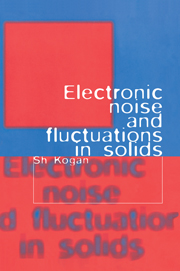Book contents
- Frontmatter
- Contents
- Preface
- Abbreviations
- 1 Introduction: Some basic concepts of the theory of random processes
- 2 Fluctuation–dissipation relations
- 3 Fluctuations in nonequilibrium gases
- 4 Generation–recombination noise
- 5 Noise in quantum ballistic systems
- 6 Resistance noise in metals
- 7 Noise in strongly disordered conductors
- 8 1/f noise and random telegraph noise
- 9 Noise in superconductors
- References
- Subject index
4 - Generation–recombination noise
Published online by Cambridge University Press: 17 March 2010
- Frontmatter
- Contents
- Preface
- Abbreviations
- 1 Introduction: Some basic concepts of the theory of random processes
- 2 Fluctuation–dissipation relations
- 3 Fluctuations in nonequilibrium gases
- 4 Generation–recombination noise
- 5 Noise in quantum ballistic systems
- 6 Resistance noise in metals
- 7 Noise in strongly disordered conductors
- 8 1/f noise and random telegraph noise
- 9 Noise in superconductors
- References
- Subject index
Summary
The states of electrons and holes in semiconductors and insulators can be divided into two classes: delocalized electron states in the conduction band (holes in the valence band) and localized states. Being in a delocalized state, the charge carrier, electron or hole, contributes to the conductivity. The electrons and holes localized in impurities or defects do not participate in the conduction (they can participate in hopping conduction but its mobility is comparatively much lower). The transition of an electron or a hole from a localized state to a delocalized one or the creation of an electronhole pair is called generation, the inverse process is called recombination. The term ‘trapping’ is also used when an electron or a hole is captured by an impurity. A comprehensive review of the physics of nonradiative recombination processes is presented in the book by Abakumov, Perel' & a Yassievich (1991).
Since the elementary generation and recombination processes are random, the number of charge carriers, i.e., electrons or holes in delocalized states, fluctuates around some mean value which determines the mean conductance of the specimen. The fluctuations of the charge carriers' number produce fluctuations of the resistance and, consequently, of current and/or voltage if a nonzero mean current is passing through the specimen. This noise is called generation-recombination noise (G-R noise). It is, perhaps, the most important mechanism of modulation noise, i.e., noise produced by random modulation of the resistance.
- Type
- Chapter
- Information
- Electronic Noise and Fluctuations in Solids , pp. 118 - 129Publisher: Cambridge University PressPrint publication year: 1996

